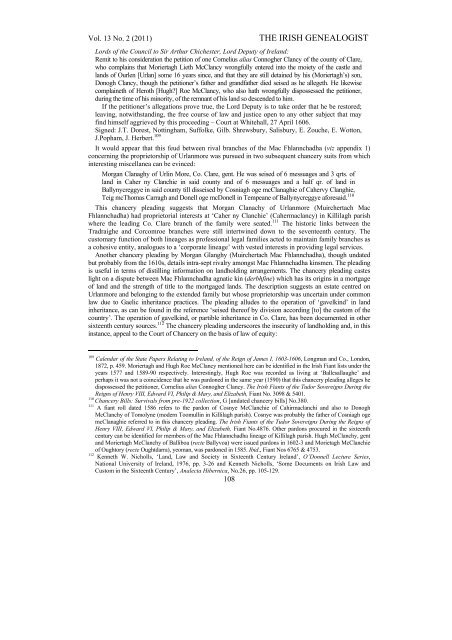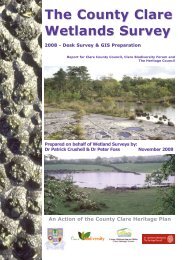A Mac Fhlannchadha Fosterage Document, c.1580 - Clare County ...
A Mac Fhlannchadha Fosterage Document, c.1580 - Clare County ...
A Mac Fhlannchadha Fosterage Document, c.1580 - Clare County ...
Create successful ePaper yourself
Turn your PDF publications into a flip-book with our unique Google optimized e-Paper software.
Vol. 13 No. 2 (2011)THE IRISH GENEALOGISTLords of the Council to Sir Arthur Chichester, Lord Deputy of Ireland:Remit to his consideration the petition of one Cornelius alias Connogher Clancy of the county of <strong>Clare</strong>,who complains that Moriertagh Lieth McClancy wrongfully entered into the moiety of the castle andlands of Ourlen [Urlan] some 16 years since, and that they are still detained by his (Moriertagh’s) son,Donogh Clancy, though the petitioner’s father and grandfather died seised as he allegeth. He likewisecomplaineth of Heroth [Hugh?] Roe McClancy, who also hath wrongfully dispossessed the petitioner,during the time of his minority, of the remnant of his land so descended to him.If the petitioner’s allegations prove true, the Lord Deputy is to take order that he be restored;leaving, notwithstanding, the free course of law and justice open to any other subject that mayfind himself aggrieved by this proceeding – Court at Whitehall, 27 April 1606.Signed: J.T. Dorest, Nottingham, Suffolke, Gilb. Shrewsbury, Salisbury, E. Zouche, E. Wotton,J.Popham, J. Herbert. 109It would appear that this feud between rival branches of the <strong>Mac</strong> <strong>Fhlannchadha</strong> (viz appendix 1)concerning the proprietorship of Urlanmore was pursued in two subsequent chancery suits from whichinteresting miscellanea can be evinced:Morgan Clanaghy of Urlin More, Co. <strong>Clare</strong>, gent. He was seised of 6 messuages and 3 qrts. ofland in Caher ny Clanchie in said county and of 6 messuages and a half qr. of land inBallynycreggye in said county till disseised by Cosniagh oge mcClanaghie of Cahervy Clanghie,Teig mcThomas Carragh and Donell oge mcDonell in Tempeane of Ballynycreggye aforesaid. 110This chancery pleading suggests that Morgan Clanachy of Urlanmore (Muirchertach <strong>Mac</strong><strong>Fhlannchadha</strong>) had proprietorial interests at ‘Caher ny Clanchie’ (Cahermaclancy) in Killilagh parishwhere the leading Co. <strong>Clare</strong> branch of the family were seated. 111 The historic links between theTradraighe and Corcomroe branches were still intertwined down to the seventeenth century. Thecustomary function of both lineages as professional legal families acted to maintain family branches asa cohesive entity, analogues to a ‘corporate lineage’ with vested interests in providing legal services.Another chancery pleading by Morgan Glanghy (Muirchertach <strong>Mac</strong> <strong>Fhlannchadha</strong>), though undatedbut probably from the 1610s, details intra-sept rivalry amongst <strong>Mac</strong> <strong>Fhlannchadha</strong> kinsmen. The pleadingis useful in terms of distilling information on landholding arrangements. The chancery pleading casteslight on a dispute between <strong>Mac</strong> <strong>Fhlannchadha</strong> agnatic kin (derbhfine) which has its origins in a mortgageof land and the strength of title to the mortgaged lands. The description suggests an estate centred onUrlanmore and belonging to the extended family but whose proprietorship was uncertain under commonlaw due to Gaelic inheritance practices. The pleading alludes to the operation of ‘gavelkind’ in landinheritance, as can be found in the reference ‘seised thereof by division according [to] the custom of thecountry’. The operation of gavelkind, or partible inheritance in Co. <strong>Clare</strong>, has been documented in othersixteenth century sources. 112 The chancery pleading underscores the insecurity of landholding and, in thisinstance, appeal to the Court of Chancery on the basis of law of equity:109 Calendar of the State Papers Relating to Ireland, of the Reign of James I, 1603-1606, Longman and Co., London,1872, p. 459. Moriertagh and Hugh Roe McClancy mentioned here can be identified in the Irish Fiant lists under theyears 1577 and 1589-90 respectively. Interestingly, Hugh Roe was recorded as living at ‘Ballesallaughe’ andperhaps it was not a coincidence that he was pardoned in the same year (1590) that this chancery pleading alleges hedispossessed the petitioner, Cornelius alias Connogher Clancy. The Irish Fiants of the Tudor Sovereigns During theReigns of Henry VIII, Edward VI, Philip & Mary, and Elizabeth, Fiant No. 3098 & 5401.110Chancery Bills: Survivals from pre-1922 collection, G [undated chancery bills] No.380.111 A fiant roll dated 1586 refers to the pardon of Cosnye McClanchie of Cahirmaclanchi and also to DonoghMcClanchy of Tomolyne (modern Toomullin in Killilagh parish). Cosnye was probably the father of Cosniagh ogemcClanaghie referred to in this chancery pleading. The Irish Fiants of the Tudor Sovereigns During the Reigns ofHenry VIII, Edward VI, Philip & Mary, and Elizabeth, Fiant No.4876. Other pardons procured in the sixteenthcentury can be identified for members of the <strong>Mac</strong> <strong>Fhlannchadha</strong> lineage of Killilagh parish. Hugh McClanchy, gentand Moriertagh McClanchy of Balliboa (recte Ballyvoa) were issued pardons in 1602-3 and Morietagh McClanchieof Oughtory (recte Oughtdarra), yeoman, was pardoned in 1585. Ibid., Fiant Nos 6765 & 4753.112 Kenneth W. Nicholls, ‘Land, Law and Society in Sixteenth Century Ireland’, O’Donnell Lecture Series,National University of Ireland, 1976, pp. 3-26 and Kenneth Nicholls, ‘Some <strong>Document</strong>s on Irish Law andCustom in the Sixteenth Century’, Analecta Hibernica, No.26, pp. 105-129.108
















